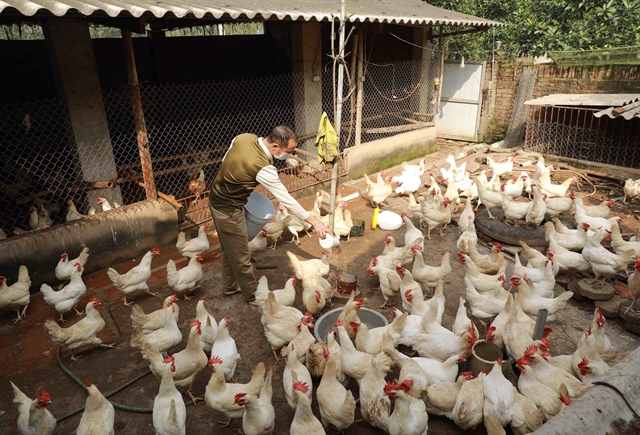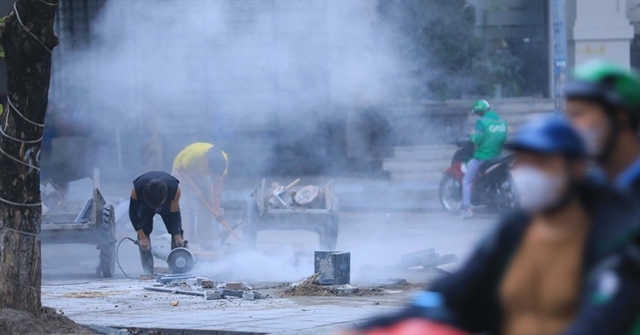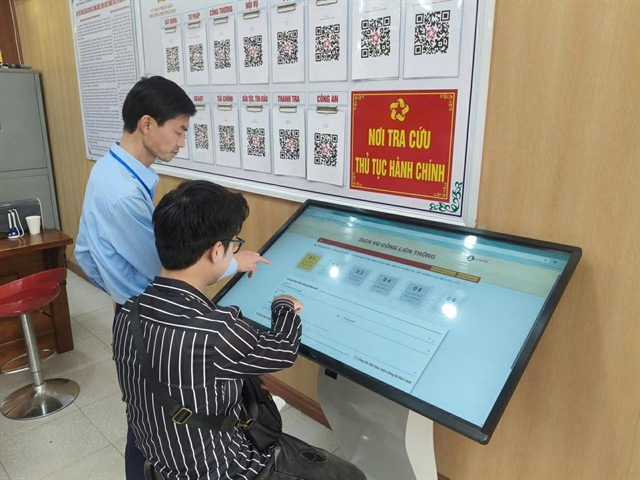 Society
Society

 |
| A farmer takes care of his chicken in Kim Chu Village, Bắc Sơn Commune, Sóc Sơn District in Hà Nội. — VNA/VNS Photo Vũ Sinh |
HÀ NỘI — Hà Nội's agriculture sector has many issues hindering it from developing commensurate with its potential and advantages, with experts warning it has a long way to go to become an ideal model for agricultural development associated with rural urbanisation.
Speaking about the difficulties of Hà Nội's agricultural industry, associate professor Đặng Văn Đông from the Fruit and Vegetable Research Institute said at present, Hà Nội's agriculture and rural areas are under tremendous pressure from the urbanisation process.
Rapid urbanisation, residential area construction, industrial parks and socio-economic infrastructure works are being built, leading to several agricultural lands being divided. Many canals are blocked to serve irrigation and drainage. This is the cause why many farmers leave their fields to find new work.
Concerned about labour sources for agricultural production, associate professor Đào Thế Anh, deputy director of the Việt Nam Institute of Agricultural Sciences, said that young workers tend to move from the agricultural to the industrial sector. This has a direct impact on the farm workforce.
The 'ageing' agricultural workforce and seasonal worker shortage must be mentioned; production organisation has not met the requirements of developing highly competitive agriculture.
In recent years, climate change has caused natural disasters and epidemics on crops and livestock. As a result, farmers face many challenges and risks, while the value of agricultural production is lower than other economic sectors, so farmers are not interested in agriculture.
Assessing limitations of Hà Nội's agriculture, Lê Thành Ý, from the Việt Nam Association of Agricultural Science and Development, said that the percentage of agricultural products that are well processed was still low.
Post-harvest preservation technology has not yet met the requirements.
The use of waste products and by-products has not been given due attention, whereas supporting industries that should perfect products is underdeveloped.
Another problem is that the capital city does not have many breakthrough policies to encourage enterprises to invest in the agricultural sector, especially high-technology applications in cultivation, husbandry and processing.
Promoting typical strengths
To solve difficulties and challenges and turn advantages and potentials into a driving force for agricultural development, Hà Nội identifies agricultural production as the foundation and should integrate other economic activities.
Director of the Hà Nội Department of Agriculture and Rural Development Chu Phú Mỹ informed that the city developed specialised agricultural areas in association with tourism development to increase production value.
The city will also invest methodically in agricultural models in an intensive direction.
The city encourages farmers to exploit the strengths of agriculture to develop community-based tourism towards two goals; rural areas will be a weekend relaxation space for inner-city people and worth-living countryside for residents.
Hà Nội is also gradually forming high-quality seedling areas, including fruit trees, ornamental flowers and urban trees, to meet the requirements of green urban development.
Agricultural production areas invested in technology and finance will become high-tech agriculture centres and sustainable ecological agriculture development.
For example, Gia Lâm District will form a high-tech garden house which supplies plant varieties for the whole region. Mê Linh District will become the "capital" of ornamental flowers. Sóc Sơn, Ba Vì, and Thường Tín districts are the land of organic agriculture associated with ecotourism.
Speaking about long-term solutions, the deputy chairman of the Hà Nội People's Committee, Nguyễn Mạnh Quyền, said Hà Nội is in the process of urbanisation and agriculture. Therefore, it needs to promote intellectual, financial, scientific and technological resources to build models to enhance value.
In the future, Hà Nội will continue to study and perfect planning and propose the authorities to amend the Capital Law, creating a legal basis for building policies for agricultural development.
"The city's leaders are always concerned about how the capital's agriculture can promote the unique strengths of Thăng Long – Hà Nội, make breakthroughs and become a national example of science, technology, and quality ecology," said Quyền.
Agricultural and forestry areas in Hà Nội cover up to 200,000ha, accounting for 58.91 per cent of the total area. The rural population is over 4.1 million people, accounting for 50.7 per cent of the total population. The rural labour force is 2.2 million people, accounting for over 56 per cent of the city's labour force.
Hà Nội has developed specialised production areas, including 22 places for organic vegetables, 25 places for high-quality rice, 14 others for fruit trees, ten for flowers and plants and five for tea production.
It has 76 key husbandry communes and 20 places for aquaculture areas ensuring disease prevention and environmental sanitation. — VNS




